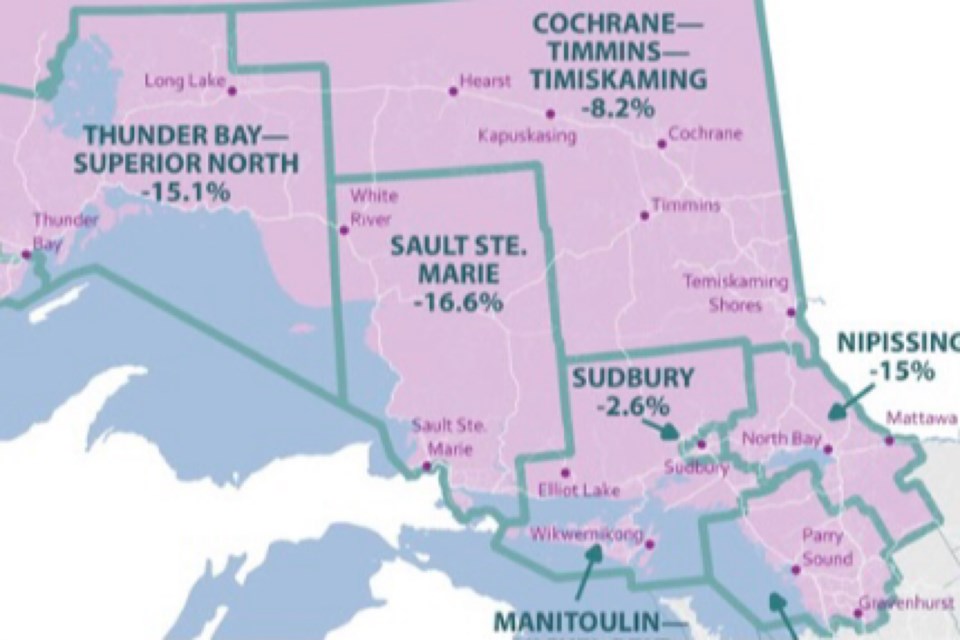If Sault MP Terry Sheehan runs in the next federal election, he might have many miles of supplementary stumping to do to keep his job.
Proposed changes to federal electoral boundaries show Sheehan's Sault Ste. Marie riding expanded to several times its existing size.
The rejiggered riding would have a population of 97,299 souls, up more than 17,000 from the current 80,371.
In addition to Sault Ste. Marie, the new riding would include Bruce Mines, Thessalon, Wawa, most of Huron Shores, Chapleau, Dubreuilville, Hilton, Jocelyn, Johnson, Laird, Macdonald, Meredith and Aberdeen Additional, Plummer Additional, Prince, St. Joseph, Tarbutt, and White River, as well as Hilton Beach.
The following First Nations reserves are also proposed for inclusion in Sault Ste. Marie riding:
- Chapleau No. 74A
- Chapleau No. 75
- Chapleau Cree Fox Lake
- Duck Lake No. 76B
- Garden River No. 14
- Goulais Bay No. 15A
- Gros Cap No. 49
- Obadjiwan No. 15E
- Rankin Location No. 15D
- Thessalon No. 12
Currently, the Sault riding generally lies between the Montreal River to the north and St. Marys River and North Channel to the south.
The venerable name 'Algoma' will disappear from federal electoral maps, with Elliot Lake becoming part of of a newly named Manitoulin-Nickel Belt riding.
The proposed boundary changes were announced by the Federal Electoral Boundaries Commission for Ontario at 5:07 p.m. on Friday.
In a news release, the commission described the boundary-adjusting process as "independent and non-partisan."
"In exercising its mandate under the Electoral Boundaries Readjustment Act and given the allocation of one additional district to Ontario, the commission found it necessary to propose many new electoral boundaries to correct wide variations in voter equality that have emerged across the province over the past decade due to population change," said the Honourable Justice Lynne C. Leitch, chair of the three-member commission.
The following quotes are taken directly from the electoral boundaries commission website:
"There was only modest population growth in Northern Ontario over the past decade."
"The population of northern Ontario grew by 2.8 per cent from 831,984 in 2011 to 855,138 in 2021. The remainder of Ontario grew by 11.2 per cent in the same period."
"The census population data and mandate respecting voter parity revealed the potential for a reduction of two electoral districts in northern Ontario."
"The commission considered this possibility but decided to propose a reduction of one district, thus resulting in nine districts in total, including one 'extraordinary circumstances' district.
"The commission acknowledged that most of the eight non-extraordinary districts in northern Ontario have significant deviations from the quota. However, the commission concluded that any further reduction in the number of districts in the north would imperil the principle of effective representation in this part of the province, considering its widely dispersed population and communities of interest."
"The proposed redistribution plan establishes one 'extraordinary circumstances' district which encompasses and reflects the exceptional nature of the far north – an isolated and geographically substantial area, in large part not accessible by road, in which the majority of the population is Indigenous."
"While geographically vast (520,307 square kilometers), the proposed district of Kiiwetinoong Mushkegowuk would not be the largest in Canada and, furthermore, is accessible via regular flight routes (from the Timmins hub along the James Bay coast and from hubs in Thunder Bay, Sioux Lookout and Winnipeg serving the western portion.)"
"The eight other proposed electoral districts in northern Ontario are of manageable geographic size, and accessible via the well-established roadway network anchored by Highways 11 and 17. Their boundaries have also been redrawn to reduce the large deviations from the quota."
Eleven in-person public consultations are planned for late September and October across the province, but the only ones in northern Ontario are in Sioux Lookout, Kenora and Timmins.
There will also be six virtual hearings, including one on Wednesday, Oct. 26, dedicated to northern Ontario, central Ontario and Ottawa.
The new ridings may can be put in place only at a general election called at least seven months after the new electoral districts have been established.
It's expected the new boundaries will take effect during an election held after Apr. 1, 2024 at the earliest.
